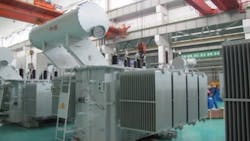Cause of Hydrogen Gas in Transformers
Q: What is the cause of hydrogen gas in 10 mva 35 kV to 13 kV transformers? Is this a problem with one mfg in particular?
A: In order to properly diagnose a gassing problem in any particular transformer, several items must be known – history of dissolved gases, unusual events (e.g., history of lightning strikes, overloading and through faults), etc. Nevertheless, if hydrogen is the main gas being produced in significant quantities, the likely causes may be stray gassing of the oil or partial discharges in the transformer. Stray gassing of hydrogen refers to the generation of hydrogen under moderate temperatures in the transformer. The cause has been attributed to the refining process and the possible presence of certain incompatible materials in the transformer or additives in the oil. Stray gassing of hydrogen normally stabilizes after a period of time. Partial discharge is a partial breakdown in parts of the insulation structure between two electrodes at different potentials (e.g., HV to LV windings or winding to ground).
The class of transformers that is mentioned would typically have a gas space filled with nitrogen gas above the oil. During daytime the temperature rise causes the gas space pressure to increases while at the same time the oil expands. This causes some of the gas to dissolve in the oil. During the night the reverse happens: the oil contracts and the temperature drops, hence the gas space pressure drops. Ideally, all the excess gas should return to the gas space, but under some conditions the excess gas remains in the oil. Oil in this condition is considered to be supersaturated with nitrogen. Any sudden mechanical disturbance such as pump operation, lightning strike or winding movement resulting from sudden large increase in current could suddenly release the excess gas as bubbles in the oil.
Gas bubbles lower the effective dielectric constant of the oil which in turn increases the electric stress in the oil and in particular across the gas bubbles. The high stress causes voltage breakdown across the gas bubbles with release of hydrogen from the gasified oil. If the oil used is a gas absorbing oil (i.e., it has negative gassing tendency according to ASTM D2300) the effect may not last long. The aromatic molecules in the oil will absorb the hydrogen and prevent the bubbles from growing. Eventually, the tiny bubbles will be reabsorbed into the oil. On the other hand, if the oil is gas evolving (i.e., it has positive gassing tendency), the bubbles may grow in size and cause further partial discharges with generation of more hydrogen gas.
Since the cause of such gassing is an operational issue, it can happen in a transformer from any manufacturer. However, measures can be taken to minimize the possibility of this occurring in any such transformer.
George K. Frimpong, Ph.D.
Power Transformers – Basic Technology
ABB Inc.
